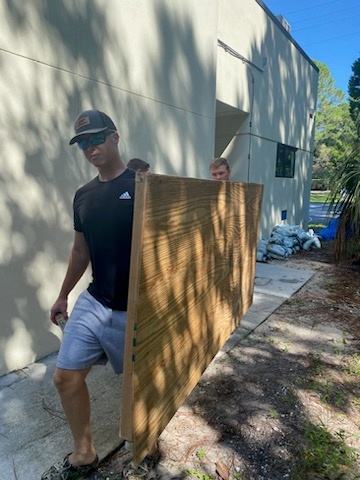


Public Affairs Detachment Tampa Bay – 305-607-6347
Editor’s Note: Social media should never be used to report life-threatening distress or emergencies, use 911 or VHF Ch. 16.
Find all U.S. Coast Guard Southeast imagery on Dvids
Find specific Hurricane Idalia prep video & photos: b-roll 1 , b-roll 2, 3 photos
CLEARWATER, Fla. — Coast Guard Sector St. Petersburg units are preparing and will respond to impacts from Hurricane Idalia as it begins to make landfall over the next few days.
Personnel are making certain aircraft, small boats, cutters, and facilities are adequately maintained or secured so they are prepared to respond. Once the storm passes, and as soon as it is safe to operate, the Coast Guard, along with our local first response and federal partners, will evaluate the need to provide life-saving support in disaster-stricken areas.
"It is essential for mariners and the public to take proper measures before a storm arrives," said Capt. Michael P. Kahle, Coast Guard captain of the port. "Ensure you secure all loose equipment, have a hurricane mooring plan or a safe place to store your trailered boat, and monitor the weather. Do not attempt to ride out the storm on your vessel."
In preparation for Hurricane Idalia, the Coast Guard recommends the following safety and preparedness tips.
Preparing for a hurricane on land:
- If you live or boat in an area prone to hurricanes or heavy weather, know your local and national weather sources and monitor them continuously.
- Remove small boats from the water and move them to safe locations that aren't likely to flood.
- Remove all EPIRBs, life rings, life jackets and loose items. Tie the boat securely to the trailer. Contact local marinas and ask for advice.
- If your boat is too large to be removed from the water, move it to a safe haven well before the storm approaches. You should know where safe havens are in the area where you boat. Use extra fenders—such as used tires—to protect your boat. Use additional mooring lines, secure all hatches, take down the mast, if possible, and remove all loose items from the vessel. Tie down everything, inside and out.
- Drawbridges along the coast may deviate from normal operating procedures prior to a storm. They are generally authorized to remain closed up to eight hours prior to the approach of gale-force winds of 34 knots or greater and whenever an evacuation is ordered. Due to the uncertainty of weather movements and related bridge closures, mariners should seek early passage through drawbridges well in advance of the arrival of gale-force winds.
- Boaters and coastal residents can get storm and hurricane information from VHF marine radios, commercial radio, television stations, newspapers or NOAA weather radios.
- Check the Coast Guard Homeport website for an updated status of local ports.
- Never forget storms move quickly, and they are unpredictable. You can always replace a boat; you cannot replace a life.
Preparing for a hurricane: Vessels in the storm
- Do not go out to sea in a recreational boat to “ride out” a hurricane. All mariners are advised to stay off the water.
- If you are unable to evade a storm, wear a life jacket and know how to activate your distress signaling devices. Rescue and assistance by the Coast Guard and other agencies, however, may be severely degraded or unavailable immediately before, during and after a devastating storm.
- If you are in a vessel and you see signs of bad weather, seek shelter. While en route to shelter, tie down loose objects on the boat and prepare passengers for possible rough water, heavy rains and high winds. Have all aboard put on life jackets, including pets. Do not let passengers below deck remove their life jackets.
- If you think the boat may sink or capsize, it may be best to keep passengers above deck and attached to safety lines.
- If you get into trouble, call for help immediately. Ideally, you should have an EPIRB on board in addition to a VHF marine radio. Keep in touch with the Coast Guard or anyone else you can reach so someone knows your location and assistance can be sent if needed and when possible.
- Carry life rafts on board large vessels. If the vessel sinks, board the life raft, stay with it and tether passengers together. Keep moving slowly to keep circulation and body temperature up and avoid overexertion.
People in distress should use 911 to request assistance whenever possible. Social media should not be used to report life-threatening distress due to limited resources to monitor the dozens of social media platforms during a hurricane or large-scale rescue event.
Port Condition changes by the Captain of the Port in advance of storm systems and hurricanes will be available on the Homeport website and announced on U.S. Coast Guard Sector St. Petersburg official unit social media page.
For more information about hurricanes and hurricane preparedness, visit NOAA’s and FEMA’s websites where you can find widgets that provide hurricane tracks and other updates. These can be found at www.ready.gov/hurricanes, www.nhc.noaa.gov, and www.fema.gov. Information is also available in Español, Français and Kreyòl.
Coast Guard Sector St. Petersburg Public Affairs contact for news media outlets:
PADET Tampa: padettampabay@gmail.com; 305-607-6347 & 305-965-4672
For breaking news, follow us on Twitter. For more information, follow us on Facebook and Instagram.